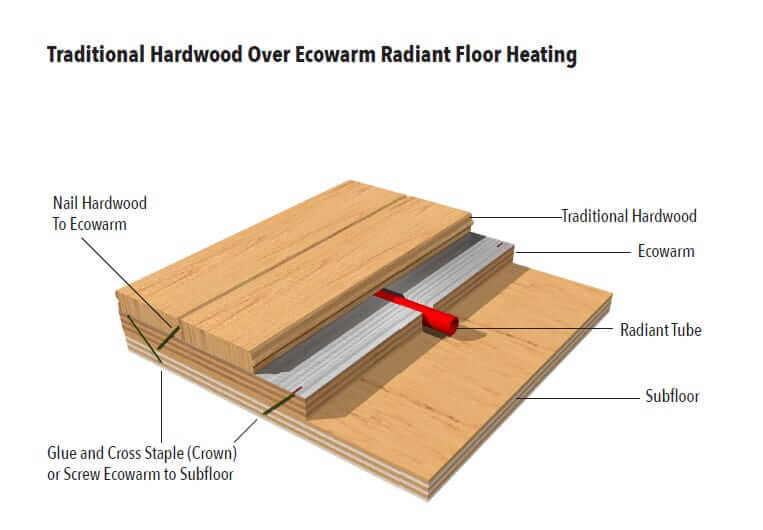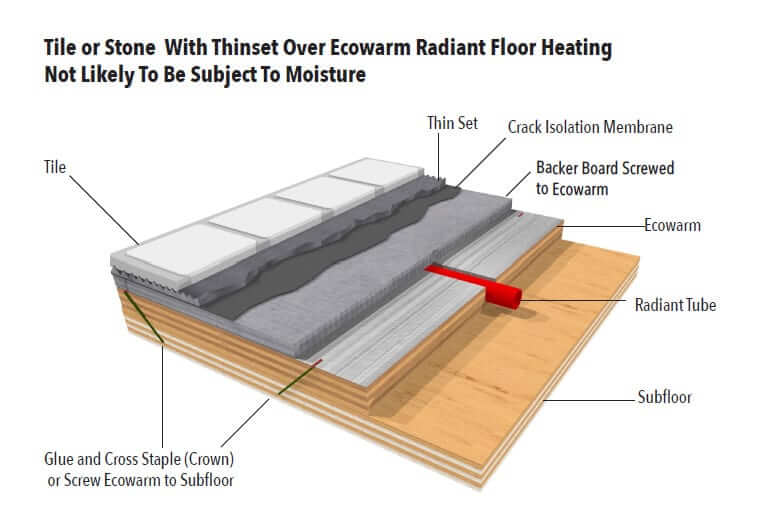Warmth Beneath Tradition: Installing Wood Floors Over Radiant Panels
Wood radiant floor heating installation offer homeowners a seamless combination of aesthetic beauty and high-performance heating. With WBI’s advanced radiant panel systems, Thermalboard and Ecowarm RadiantBoard, you can confidently install traditional hardwood flooring while ensuring even warmth, reduced energy costs, and long-term comfort.
A conventional nailed hardwood system may be used directly over the panels with nailing long enough to penetrate the subfloor and with the utilization of recommended controls. When installing wood over radiant floor heating, always orient the hardwood flooring direction perpendicular to the tubing.
Hardwood floors with radiant heat underneath provide a seamless combination of aesthetics and functionality. It is important to follow manufacturer guidelines regarding temperature settings to prevent damage to the wood and ensure long-term durability.
Why Wood and Radiant Heat Work Well Together
Wood is a natural and elegant flooring choice, and when paired with radiant heat, it creates a cozy, luxurious living space. Radiant heating warms the floor surface directly, allowing heat to rise evenly throughout the room without the need for forced air or visible equipment.

Traditional Hardwood over radiant floor heating
Benefits of Installing Wood Radiant Floor Heating
1. Silent, Even Heat
Enjoy the peaceful warmth of radiant heating with no noisy vents, fans, or airflow disruptions. The system delivers consistent, uniform heat directly from the floor, eliminating cold spots and enhancing overall comfort in your living spaces.
2. Improved Energy Efficiency
Radiant floor systems operate using lower water temperatures compared to traditional forced-air systems. This results in less energy consumption while maintaining a comfortable indoor environment—translating to noticeable savings on monthly utility bills.
3. Invisible Comfort
Because radiant heat is embedded beneath the floor surface, there are no visible radiators, ducts, or registers. This opens up more flexibility in room design, allowing for clean aesthetics and freedom in furniture layout.
4. Zonal Heating Flexibility
With the ability to set different temperatures in each room or zone, radiant heating under wood floors gives you customized control. Whether it’s a cozy living room or a warm bedroom, you can tailor comfort levels to meet your needs while optimizing energy use.
Best Practices for Installing Wood Over Radiant Panels
To protect your flooring investment and optimize system performance, follow these proven installation guidelines:
1. Choose the Right Flooring
-
Engineered hardwood is recommended due to its dimensional stability and compatibility with radiant heat.
-
If using solid hardwood, choose stable species like oak, cherry, or ash and avoid moisture-sensitive woods like maple or hickory.
2. Acclimation and Moisture Management

Tile or Stone over Ecowarm with Vapor Barrier
-
Let wood flooring acclimate in the installation environment for 5–7 days.
-
Maintain stable indoor humidity levels (30%–50%) to prevent cupping or gapping.
-
Use a moisture barrier where required to prevent subfloor vapor intrusion.
3. Flooring Installation Tips
-
Maintain a surface temperature limit of 80–85°F to protect the wood and ensure comfort.
-
Use a floating, glue-down, or nail-down method, following the wood manufacturer’s recommendations.
-
If nailing over WBI panels, take care to avoid puncturing the radiant tubing. Use the panel groove layout as a guide.
Panel System Compatibility
WBI’s Thermalboard and Ecowarm RadiantBoard are designed for compatibility with a wide range of flooring types, including engineered and solid hardwood. These systems feature:
a. Low-profile and lightweight construction
b. Precision grooved channels for ½” PEX tubing
c. High conductivity for fast thermal response
d. Durable surface laminate to withstand flooring installation
e. Environmentally friendly materials with no VOCs or formaldehyde
Surface Preparation and Control
a. Install a floor sensor and smart thermostat to maintain consistent temperatures and avoid overheating.
b. Use underlayment or thin plywood, if needed, to protect tubing when fastening floors.
c. Ensure tubing has been pressure tested before installing the wood flooring.
Final Words
Wood radiant floor heating installations are a beautiful and practical solution for modern and traditional homes alike. With WBI’s expertly engineered radiant panel systems, your wood flooring will not only look stunning but also provide a comfortable, energy-efficient environment year-round.

